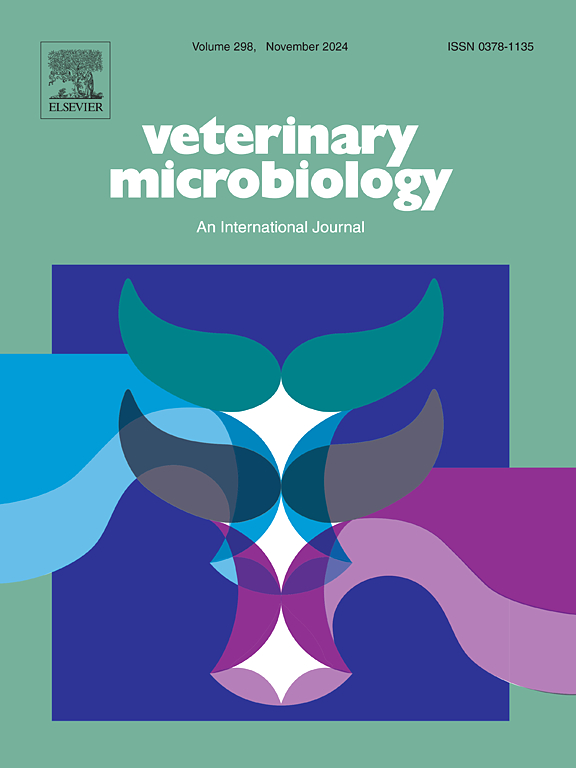Streptococcus suis AdcA interacts with factor H and inhibits C3b deposition on the bacteria to participate in complement evasion
IF 2.4
2区 农林科学
Q3 MICROBIOLOGY
引用次数: 0
Abstract
Streptococcus suis is an important zoonotic pathogen. It can escape from the host complement attack through various strategies. In this study, the possible complement C3b interacted proteins of S. suis were screened by co-immunoprecipitation (Co-IP) using C3b antibody in human serum. A bacterial Zn2+ transporter AdcA detected to be a cell wall protein was identified. The interaction of AdcA with C3b was verified in the same Co-IP setup using AdcA antibody by western-blot, but after far-western blot analysis, AdcA was found to not interact with C3b directly, but interacted directly with factor H (FH), the complement regulatory factor inhibiting the cleavage of C3 and the production of C3b. Thereafter, the interaction sites of AdcA and FH were predicted using molecular docking. Then, an adcA gene deletion mutant ΔadcA, a complementary strain CΔadcA and point mutant strains containing AdcA-FH interaction sites ΔadcAFH(P-G) (N-terminal) and ΔadcAFH(Y-P) (C-terminus) were constructed. The deposition of C3b on the surface of ΔadcA, ΔadcAFH(P-G) and ΔadcAFH(Y-P) was significantly increased compared to the wild-type (WT) or CΔadcA. The resistance to opsonophagocytosis and survival rates in serum of ΔadcA and ΔadcAFH(P-G) were significantly reduced compared to WT or CΔadcA. Additionally, deletion of adcA decreased bacterial loads of S. suis in the blood, brain and lung of mice. Taken together, AdcA inhibited C3b deposition on the surface of S. suis by binding to FH, further inhibiting the C3b-mediated opsonophagocytosis and serum survivability of S. suis. Both the complement evasion and the known Zn2+ transport roles of AdcA contributed to pathogenicity of S.suis.
猪链球菌AdcA与H因子相互作用,抑制C3b在细菌上的沉积,参与补体逃避
猪链球菌是一种重要的人畜共患病原体。它可以通过各种策略逃避宿主补体的攻击。本研究采用人血清C3b抗体共免疫沉淀法(Co-IP)筛选猪链球菌可能的补体C3b相互作用蛋白。鉴定了细菌Zn2+转运体AdcA为细胞壁蛋白。在相同的Co-IP设置中,使用AdcA抗体通过western-blot验证了AdcA与C3b的相互作用,但经过远western blot分析,发现AdcA不直接与C3b相互作用,而是直接与H因子(FH)相互作用,FH是抑制C3裂解和C3b产生的补体调节因子。然后,利用分子对接的方法预测AdcA和FH的相互作用位点。然后构建adcA基因缺失突变株ΔadcA、互补菌株CΔadcA和含有adcA - fh相互作用位点ΔadcAFH(P-G) (n端)和ΔadcAFH(Y-P) (c端)的点突变株。与野生型(WT)和CΔadcA相比,ΔadcA、ΔadcAFH(P-G)和ΔadcAFH(Y-P)表面C3b的沉积量显著增加。与WT或CΔadcA相比,ΔadcA和ΔadcAFH(P-G)的抗噬功能和血清存活率显著降低。此外,adcA的缺失降低了小鼠血液、脑和肺中猪链球菌的细菌载量。综上所述,AdcA通过与FH结合抑制C3b在猪链球菌表面的沉积,进一步抑制C3b介导的调节噬细胞作用和猪链球菌的血清生存能力。AdcA的补体逃避和已知的Zn2+转运作用都参与了猪链球菌的致病性。
本文章由计算机程序翻译,如有差异,请以英文原文为准。
求助全文
约1分钟内获得全文
求助全文
来源期刊

Veterinary microbiology
农林科学-兽医学
CiteScore
5.90
自引率
6.10%
发文量
221
审稿时长
52 days
期刊介绍:
Veterinary Microbiology is concerned with microbial (bacterial, fungal, viral) diseases of domesticated vertebrate animals (livestock, companion animals, fur-bearing animals, game, poultry, fish) that supply food, other useful products or companionship. In addition, Microbial diseases of wild animals living in captivity, or as members of the feral fauna will also be considered if the infections are of interest because of their interrelation with humans (zoonoses) and/or domestic animals. Studies of antimicrobial resistance are also included, provided that the results represent a substantial advance in knowledge. Authors are strongly encouraged to read - prior to submission - the Editorials (''Scope or cope'' and ''Scope or cope II'') published previously in the journal. The Editors reserve the right to suggest submission to another journal for those papers which they feel would be more appropriate for consideration by that journal.
Original research papers of high quality and novelty on aspects of control, host response, molecular biology, pathogenesis, prevention, and treatment of microbial diseases of animals are published. Papers dealing primarily with immunology, epidemiology, molecular biology and antiviral or microbial agents will only be considered if they demonstrate a clear impact on a disease. Papers focusing solely on diagnostic techniques (such as another PCR protocol or ELISA) will not be published - focus should be on a microorganism and not on a particular technique. Papers only reporting microbial sequences, transcriptomics data, or proteomics data will not be considered unless the results represent a substantial advance in knowledge.
Drug trial papers will be considered if they have general application or significance. Papers on the identification of microorganisms will also be considered, but detailed taxonomic studies do not fall within the scope of the journal. Case reports will not be published, unless they have general application or contain novel aspects. Papers of geographically limited interest, which repeat what had been established elsewhere will not be considered. The readership of the journal is global.
 求助内容:
求助内容: 应助结果提醒方式:
应助结果提醒方式:


